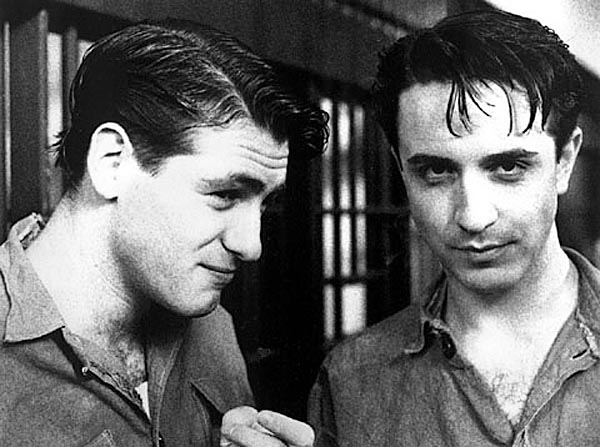 |
| Daniel Schlachet and Craig Chester in Swoon |
This is a guest review by Eli Lewy.
Richard Loeb (Daniel Schlachet) and Nathan Leopold (Craig Chester) are enamored with each other. Yet their life is complicated. For one thing, they are two men engaging in a homosexual libidinous relationship in the 1920s, and secondly, they are burgeoning sociopaths. Richard and Nathan desire to commit the perfect crime together and murder an innocent young boy in cold blood for sheer unadulterated thrills.
Tom Kalin’s Swoon is based on a true event, a case that has been adapted by Hitchcock in Rope and Richard Fliescher in Compulsion. However, these two films focus on the psychological makeup of the couple and the court proceedings while purposefully omitting the couple’s homosexuality. Swoon is heralded as one of New Queer Cinema’s triumphs, a film movement that arose in the early 1990s and was lead by openly gay filmmakers like Todd Haynes, Gus Van Sant, and Greg Araki. The transgressive subgenre sought to question heteronormative notions and address queer issues in an explicit way. Kalin chooses to focus on the pathologizing nature of legal and medical institutions and the anti-gay sentiments that were pervasive in the past. Swoon makes use of the transcription of the actual court case, in which it was argued that Richard and Nathan committed the heinous crime because they were deranged perverts filled with unnatural lusts. This is Kalin’s focus, and he proceeds to deconstruct society’s deeply ingrained attitudes.
Swoon’s first scene is a visual whirlwind, a collection of historical footage, gender-bending narrators, and destructive behavior. Richard and Nathan’s romance is invigorated by their petty crimes, but their goal is to take a life, an act they believe will bind them forever. The two privileged men, clearly influenced by Nietzche’s Superman theory, (which in hindsight is most troubling because the pair was Jewish) believe they are above the law and the morals which society is built on. They are constantly in search of something beyond intelligence, something they claim is more pure. Viewers spend a lot of time with the couple, both in their intimate and their despicable moments; so much so that their actions seem uncomfortably real and close.
Swoon reassesses history and the demonization of minorities by dissecting the identity politics of the 1920s, juxtaposing it with anachronistic elements belonging to a different era, like dial up telephones and remote controls. The point of this cinematic device is clear, though Swoon is set in crime-ridden Chicago of the 1920s in crisp black and white, the issues at hand are timeless. Gayness is still seen as something abnormal, an intrinsic default, by many. However, the modern-day parallel is too on the nose at times. The interspersed appearance of several drag queens falls flat, for example. In the 1920s it was unclear what was worse, being a murderer or a homosexual, and Kalin delves into this social frame of mind in a chillingly astute way.
———-
Eli Lewy is a third culture kid and Masters student studying US Studies. She currently resides in Berlin. She is a movie addict and has a film blog which you can find under www.film-nut.tumblr.com
